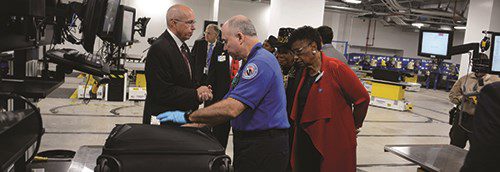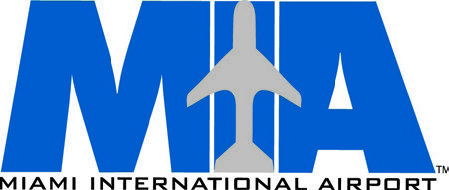With unprecedented growth of 1 million annual passengers, Miami International Airport (MIA) hit a record 45 million passengers in 2018. Moreover, 2019 appears to be on the same track.
With unprecedented growth of 1 million annual passengers, Miami International Airport (MIA) hit a record 45 million passengers in 2018. Moreover, 2019 appears to be on the same track.
Much of the volume comes from routes to Latin America and the Caribbean; and the area’s thriving cruise industry is also fueling the surge. Either way, the passenger growth translates into more suitcases, duffle bags and golf clubs for the airport to process.
When officials announced MIA’s largest capital improvement initiative ever, it was no surprise that the program included a new state-of-the-art baggage system for the Central and South Terminals. The $324 million system contains the latest X-ray machines available and autonomous mobile inspection tables.
|
Project: New Baggage Handling System Location: Miami Int’l Airport Cost: $324 million Funding: $101.2 million TSA grant; Miami-Dade Aviation Dept. bonds; Florida DOT grant New Reconciliation Area: 18,000 sq. ft. Key Technology: 12 CTX 9800 SEIO ISD machines from Smiths Detection; 102 Mobile Inspection Tables from Daifuku Airport Technologies-Jervis B. Webb Co. Processing Capacity: Up to 7,000 bags/hour; system will serve 50+ airlines when fully operational Construction Manager: Parsons/Odebrecht Joint Venture BHS Main Subcontractor: Daifuku Airport Technologies-Jervis B. Webb Co. BHS Control System: Brock Controls BHS Design/Planning: Burns & McDonnell BHS Electrical: Miller Electric Conveyor Installation: Jordim Int’l |
Members of the project team note that the system’s new checked bag resolution areas can operate independently, but they share a new common facility that features the industry’s largest installation of mobile inspection tables to date.
A TSA grant funded $101.2 million of the overall project cost, as the new system will improve screening efficiency, enhance passenger safety and improve working conditions for its staff. The mobile inspection tables, for instance, reduce physical strain for TSA officers performing secondary baggage inspection.
Integration Takes Time
A soft opening this past summer helped ease the airport into using the higher-tech components; and airlines continue to transition onto the system gradually.
“Building out a new baggage system is stressful enough,” says MIA Director Lester Sola. “Adding new technologies adds a significant layer of difficulty. Our staff has done an excellent job keeping the airport up and running, ensuring the safety of our
flying public.”
With more than 45 million people passing through MIA each year, shutting down areas of the baggage system to renovate was not an option. Instead, Parsons/Odebrecht Joint Venture (the project’s construction manager) tackled the job step-by-step, shifting each part of the baggage process over to the new system in 29 phases.
“That’s why we’re going to finish in 2020,” says Tommy Valentine, construction manager for the joint venture. “On July 29, we activated the new building with the new system, and integrated a few airlines at that time.”
Eventually, the system will be used by more than 50 airlines. In early December, 21 had already made the switch.
By 2040, the airport is projecting an annual influx of 77 million passengers and 4 million tons of freight. “The system is designed for another five to 10 years of growth,” notes Valentine.

Burns & McDonnell worked closely with project stakeholders to develop the phased plan that allowed the baggage system to remain fully operational throughout the project, says Project Manager Joe Pericich. It also worked with other team members to convert the concept design into construction drawings.
System Highlights
Upgraded technology is the keystone of the new system. For instance, 12 new CTX 9800 explosives detection systems from Smiths Detection will do the job of the 25 older models they replaced. The new machines provide high-level 3-D imaging that can detect certain components, such as metal, inside bags.
Sola notes that the new imaging technology is a considerable improvement for the airport, because many of MIA’s passengers pack items to conduct business throughout the U.S. and across country borders. “One of the bags opened recently was full of costume jewelry,” he explains. “This level of screening is now done by the system, which can highlight an area of concern.”
 The mobile inspection tables by Daifuku Airport Technologies-Jervis B. Webb Co. are another notable feature. The tables carry bags for secondary screening autonomously—no one “drives them,” notes Sola. It may look like the tables are moving all over the place, but the system sends each one to the next available TSA inspector, he adds.
The mobile inspection tables by Daifuku Airport Technologies-Jervis B. Webb Co. are another notable feature. The tables carry bags for secondary screening autonomously—no one “drives them,” notes Sola. It may look like the tables are moving all over the place, but the system sends each one to the next available TSA inspector, he adds.
“Efficiency increases because the bags move quicker, but also because the production time for agents is constant when they are not having to go anywhere [to retrieve or return bags to a conveyor],” explains Sola.
“The technology is unbelievable,” agrees Valentine, noting that Daifuku Airport Technologies-Jervis B. Webb Co. has a rich history with conveyor technology for automotive manufacturing. “The guys with Brock Controls are unbelievable, too. There are a million wires in this thing, and the technology they brought in to control miles of conveyor systems is amazing.”
The new mobile inspection tables enhance the airport’s ability to trace individual bags through the system, adds Tim Hipp, Daifuku’s project manager at MIA. Moreover, they reduce ergonomic strain, improve room accessibility and reduce noise levels for TSA bag inspectors.
“Unlike rigid conveyors, the mobile inspection tables can facilitate a flexible layout to conform to the space available,” notes Todd Alderman, a Daifuku vice president. “Columns and other building structures can be avoided without the need to add additional equipment, which is traditionally the case with conveyors.”
He also stresses that the tables save energy, making them an “ideal green solution” for other airports to consider.
Checked Bag Resolution
The new system at MIA can process up to 7,000 bags per hour, and a high percentage of them need extra inspection, notes Valentine. That’s where the technology upgrades really shine.
New conveyors take checked bags through the new facility for standard screening. Bags that are cleared go directly to sortation piers, where they are picked up and loaded onto planes. Bags that are deemed “suspect,” are processed again through a secondary system and, if cleared, end up in the same location.
Previously, TSA agents would manually lift suspect bags from the conveyor to a table, where they opened and examined the contents. They then carried cleared bags back to a separate conveyor that moved them out of the inspection room and back into the handling system.
Today, MIA’s’ mobile inspection tables are changing all of that.
Agents no longer have to physically pick up each bag. Conveyors drop each suspect bag onto its own cart, which is moved autonomously to one of 52 staffed inspection stations. Advanced X-ray images are analyzed at the station and a TSA worker inspects the bag. If cleared, it is taken away by a mobile table with the push of a button.

For Sola, the human factor—treating people better and giving them more efficient tools—is an important part of MIA’s recent baggage system project. Eliminating the need to repeatedly pick up bags that often weigh 50 pounds or more is a huge improvement. “It also brings major savings for the federal government and taxpayers in terms of injuries and time,” Valentine adds.

Other airports have been using the mobile carts for a while, but in a smaller footprint, he notes. MIA had to make slight modifications to the architectural design of its new facility to incorporate them.
Best Practices
Valentine urges airport operators to understand what they’re getting into when investing in a new baggage handling system. “Preplanning is key,” he stresses. “Not many contractors have installed a baggage system. It’s not a building; it’s a living, breathing animal that is constantly moving and changing.”
Sitting behind a desk and reading system reviews isn’t enough, he adds. To prepare for the MIA project, Valentine visited airports across the country to ask questions, observe their technology in action and talk directly with personnel running the systems.
As a result, he was better able to anticipate and understand the challenges various participants (airlines, control staff, conveyor providers, etc.) could encounter.
Pericich agrees that baggage handling systems are highly complex and technical, and notes that it’s crucial to have team members who are up to date with current security requirements and technological advancements.
Sola emphasizes the need for airports to give their airlines the chance to weigh in about baggage system projects. This became clear when a change order to include more advanced technology was proposed late in MIA’s project (2018).

“If the users are saying they want it done that way, that makes any negative position of a change order go away,” he explains. “We need to make sure we’re doing things in partnership with our business partners, the airlines, and everyone who has a job associated with the airport.”
Sola describes TSA as an amazing partner during MIA’s recent project. He also notes that the Miami-Dade Aviation Department was highly effective working with federal and state partners. “I have never been in an agency that interacts as well as this airport does on a daily basis with mission-critical things,” says the more than 20-year industry veteran. “They all had an integral part, especially TSA, in the development and deployment of this system.”
He says teamwork among contractors, government agencies, airport staff, consultants and technology providers produced a system that will allow millions of trips to begin at MIA without a hitch. What passengers won’t see, however, are the high-tech screening machines, autonomous carts and miles of conveyors that make it all happen.


 facts&figures
facts&figures

